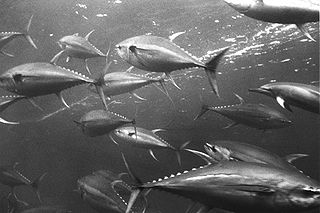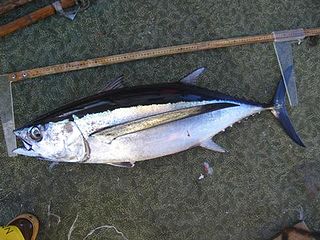
The mackerel, tuna, and bonito family, Scombridae, includes many of the most important and familiar food fishes. The family consists of 51 species in 15 genera and two subfamilies. All species are in the subfamily Scombrinae, except the butterfly kingfish, which is the sole member of subfamily Gasterochismatinae.

A dorsal fin is a fin located on the back of most marine and freshwater vertebrates within various taxa of the animal kingdom. Many species of animals possessing dorsal fins are not particularly closely related to each other, though through convergent evolution they have independently evolved external superficial fish-like body plans adapted to their marine environments, including most numerously fish, but also mammals such as cetaceans, and even extinct ancient marine reptiles such as various known species of ichthyosaurs. Most species have only one dorsal fin, but some have two or three.

The albacore, known also as the longfin tuna, is a species of tuna of the order Scombriformes. It is found in temperate and tropical waters across the globe in the epipelagic and mesopelagic zones. There are six distinct stocks known globally in the Atlantic, Pacific, and Indian oceans, as well as the Mediterranean Sea. The albacore has an elongate, fusiform body with a conical snout, large eyes, and remarkably long pectoral fins. Its body is a deep blue dorsally and shades of silvery white ventrally. Individuals can reach up to 1.4 m in length.

The yellowfin tuna is a species of tuna found in pelagic waters of tropical and subtropical oceans worldwide.

The Atlantic sailfish is a species of marine fish in the family Istiophoridae of the order Istiophoriformes. It is found in the Atlantic Ocean and the Caribbean Sea, except for large areas of the central North Atlantic and the central South Atlantic, from the surface to depths of 200 m (656 ft). The Atlantic sailfish is related to the marlin.

The Atlantic blue marlin is a species of marlin endemic to the Atlantic Ocean. It is closely related to, and usually considered conspecific with, the Indo-Pacific blue marlin, then simply called blue marlin. Some authorities consider both species distinct.

The sailfish is one or two species of marine fish in the genus Istiophorus, which belong to the family Istiophoridae (marlins). They are predominantly blue to gray in colour and have a characteristically large dorsal fin known as the sail, which often stretches the entire length of the back. Another notable characteristic is the elongated rostrum (bill) consistent with that of other marlins and the swordfish, which together constitute what are known as billfish in sport fishing circles. Sailfish live in colder pelagic waters of all Earth's oceans, and hold the record for the highest speed of any marine animal.

The double-lined mackerel, is a species of Spanish mackerel in the family Scombridae. This species is sometimes also called the scad mackerel.

The billfish are a group of saltwater predatory fish characterised by prominent pointed bills (rostra), and by their large size; some are longer than 4 m (13 ft). Extant billfish include sailfish and marlin, which make up the family Istiophoridae; and swordfish, sole member of the family Xiphiidae. They are often apex predators which feed on a wide variety of smaller fish, crustaceans and cephalopods. These two families are sometimes classified as belonging to the order Istiophoriformes, a group which originated around 71 million years ago in the Late Cretaceous, with the two families diverging around 15 million years ago in the Late Miocene. However, they are also classified as being closely related to the mackerels and tuna within the suborder Scombroidei of the order Perciformes. However, the 5th edition of the Fishes of the World does recognise the Istiophoriformes as a valid order, albeit including the Sphyraenidae, the barracudas.

The dogtooth tunaGymnosarda unicolor, also known as white tuna, is a species of pelagic marine fish which belongs to the family Scombridae.

The black marlin is a species of marlin found in tropical and subtropical areas of the Indian and Pacific Oceans. Reaching lengths of over 4.5 m (15 ft), it is one of the largest marlins and also one of the largest bony fish. Marlin are among the fastest fish, but speeds are often wildly exaggerated in popular media, such as reports of 132 km/h (82 mph). Recent research suggests a burst speed of 36 kilometres per hour (22 mph) is near the maximum rate. Black marlin are fished commercially and are also a highly prized game fish. Black marlins have been known to drag Maldivian fishing boats of the ancient times for very long distances until it got tired; and then it would then take many hours for the fishermen to row or sail back home.

The bigeye tuna is a species of true tuna of the genus Thunnus, belonging to the wider mackerel family Scombridae. In Hawaiian, it is one of two species known as ʻahi, the other being the yellowfin tuna. Bigeye tuna are found in the open waters of all tropical and temperate oceans, but not in the Mediterranean Sea.

The little tunny, also known as the false albacore, little tuna, bonita, or erroneously as the blue bonito, is a species of tuna in the family Scombridae. It can be found in the Atlantic Ocean and the Mediterranean and Black seas; in the western Atlantic, it ranges from Brazil to the New England states. The little tunny is a pelagic fish that can be found regularly in both offshore and inshore waters, and it is classified as a highly migratory species. The little tunny is best identified by the "worm-like" markings on its back and the dark spots appearing between its pectoral and ventral fins.

The blue trevally, also known as the banded trevally, barred trevally, Ferdau's trevally or Forskaal's jackfish, is a common, widespread species of pelagic marine fish classified in the jack family, Carangidae. The blue trevally is distributed throughout the tropical and subtropical waters of the Indo-Pacific and central Pacific regions, ranging from South Africa in the west to Hawaii in the east. It is a moderately large fish, growing to a recorded maximum length of 70 cm, with the number of rays in the second dorsal fin and the colouring serving as diagnostic features of the species. The species inhabits waters to depths of 60 m, generally inhabiting reefs, beaches, lagoons, and areas with sandy substrates. It is a predatory fish, taking other fish, prawns, crabs, and molluscs, and very little is known of the species' reproductive biology. The blue trevally is of varying importance to fisheries throughout its range, with some regions having high catches of the fish. It is considered to be a gamefish, and is sought after for its excellent eating qualities.

The Indo-Pacific blue marlin is a species of marlin belonging to the family Istiophoridae.

The gold-band fusilier also known as the yellow-band fusilier or black-tipped fusilier, is a species of marine ray-finned fish, a fusilier belonging to the family Caesionidae. It is widespread around reefs in the Indo-West Pacific region.

Euthynnus lineatus, the black skipjack tuna or black skipjack, is a species of ray-finned bony fish in the family Scombridae. It belongs to the tribe Thunnini, better known as the tunas.

Caesio caerulaurea, the blue and gold fusilier, blue fusilier, gold-band fusilier or scissor-tailed fusilier, is a species of marine fish in the family Caesionidae. It is widespread throughout the tropical waters of the Indo-Pacific area, including the Red Sea.

Canthidermis maculata, also known as rough triggerfish or spotted oceanic triggerfish, is a species of triggerfish native to the tropical and subtropical oceans worldwide. Unlike most triggerfish, they are mostly pelagic.

Of the twelve species of billfish, there are six species of Billfish in the Indian Ocean.






















